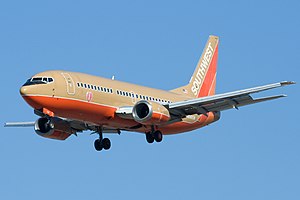| Boeing 737 Classic 737-300/-400/-500 | |
|---|---|
 Stretched from the original series and re-engined with wider CFM56 turbofans, the initial, midsize 737-300 (pictured) is the most common variant | |
| General information | |
| Type | Narrow-body aircraft |
| National origin | United States |
| Manufacturer | Boeing Commercial Airplanes |
| Status | In service |
| Primary users | UTair |
| Number built | 1,988[1] |
| History | |
| Manufactured | 1981–2000[1] |
| Introduction date | November 28, 1984, with USAir |
| First flight | February 24, 1984 |
| Developed from | Boeing 737 Original |
| Developed into | Boeing 737 Next Generation |
The Boeing 737 Classic is a series of narrow-body airliners produced by Boeing Commercial Airplanes, the second generation of the Boeing 737 series of aircraft. Development began in 1979 and the first variant, the 737-300, first flew in February 1984 and entered service that December. The stretched 737-400 first flew in February 1988 and entered service later that year. The shortest variant, the 737-500, first flew in June 1989 and entered service in 1990.
Compared to the original series, the classic series was re-engined with the CFM56, a high-bypass turbofan, for better fuel economy and had upgraded avionics. With a 133,500–150,000 lb (60.6–68.0 t) MTOW, it has a range of 2,060 to 2,375 nautical miles [nmi] (3,815 to 4,398 km; 2,371 to 2,733 mi). At 102 feet (31 m) the -500 is similar in length to the original 737-200 and can fly 110 to 132 passengers. The 110-foot-long (34 m) -300 can seat 126 to 149 passengers while the 120-foot-long (37 m) -400 accommodates 147 to 168 seats.
It competed with the McDonnell Douglas MD-80 series, then with the Airbus A320 family which prompted Boeing to update its offer with the 737 Next Generation, thus designating the -300/400/500 variants as the 737 Classic. In total, 1,988 aircraft were delivered from 1984 until production ended in the year 2000: 1,113 -300s, 486 -400s and 389 -500s.
- ^ a b Endres, Günter (2001). The Illustrated Directory of Modern Commercial Aircraft. Osceola, Wisconsin: MBI Publishing Company. pp. 126, 128–19. ISBN 0-7603-1125-0.